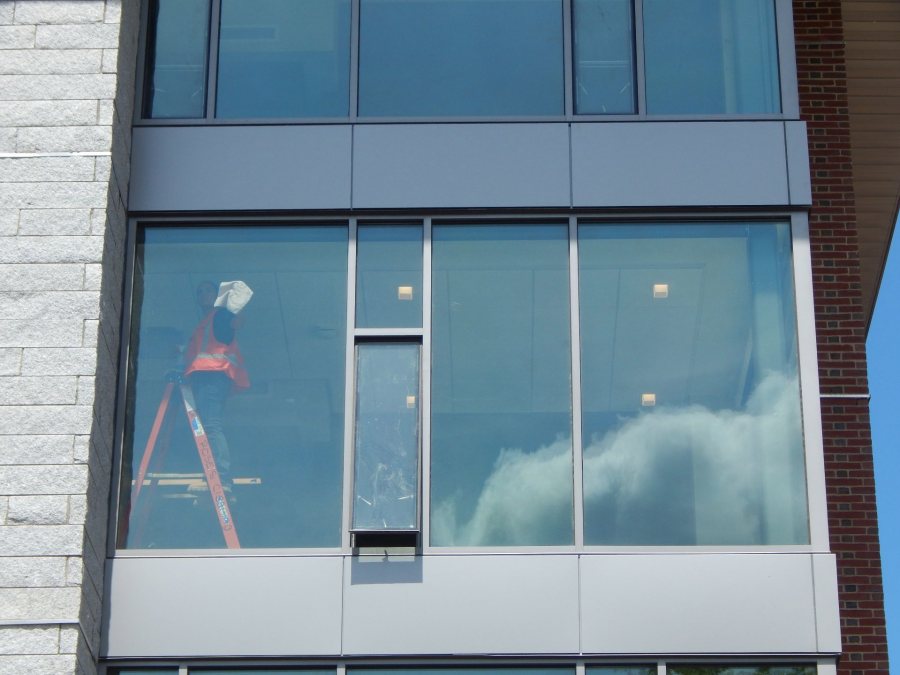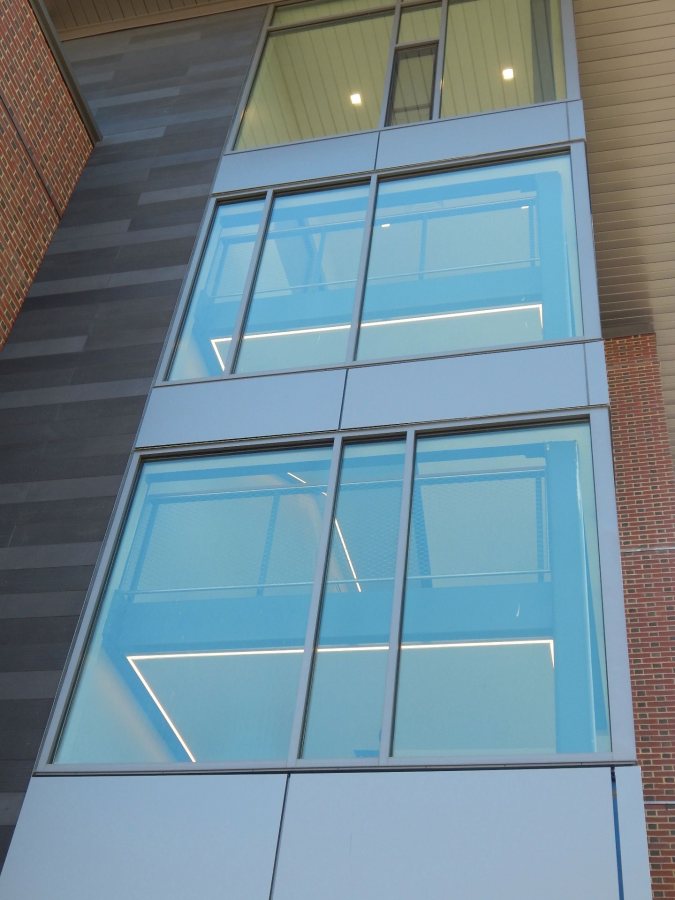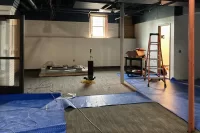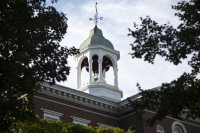
Campus Construction Update: June 3, 2016

Newly planted “Elf” mountain laurels are happy to have their toes in the ground at 65 Campus Ave. (Doug Hubley/Bates College)
People with poles poke holes in the soil and their teammates set seedlings into the holes — over and over and over again, because there are 6,000 seedlings, aka plugs, to be planted.
The week before Commencement, in a rain garden at 65 Campus Ave., employees of Gammon Landscape Nursery, of Auburn, are planting ground cover: seedlings of grasslike Pennsylvania sedge and something called barren strawberry, which isn’t a strawberry at all but, perhaps trying to compensate, does produce nice yellow flowers. (The seedlings are grown in containers that mold their roots into a plug shape — hence “plugs.”)
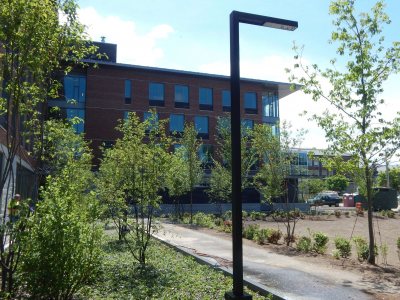
New plantings at 65 Campus Ave. on May 31, 2016. Note the ground cover at left — some 6,000 barren strawberry and sedge plants covering a storm runoff site. (Doug Hubley/Bates College)
Talk about contrasting perspectives: You could be a Gammon employee, planting plugs all day and, probably, dreaming of them all night.
Or you could be Campus Construction Update, strolling past 65 Campus Ave. one fine day and marveling at the “instantaneous” transformation of a dirt-topped drainage area into a verdant garden.
That sense of blink-of-an-eye transformation — based, of course, on hard work that probably didn’t feel so speedy to the people performing it — prevailed during May on the grounds of the new Campus Life Project residences, especially 65 Campus Ave.
Site work unrolled like a time-lapse film: new curbing replaced old, light poles popped up, pavements appeared in a cloud of smoke, topsoil flowed into graceful contours, and where did all the greenery come from?
In addition to the ground cover, Gammon planted some 200 trees and shrubs at 65 Campus. Among the shrubs are a semi-dwarf variety of mountain laurel; serviceberry, whose fruits are popular with birds; and fothergilla, which makes spiky white flowers and brilliant fall foliage ranging from yellow to scarlet.
Paid for in part by a $1,205 donation from the Class of 1960, the trees include sugar maples, white pines, blackgum, and Turkish filbert. There are also white and red oaks — the latter being an especially appropriate choice since red oak is prevalent as a wall covering and trim in both 55 and 65 Campus.
The trees arrived the second week of May. During the third week, on the Campus Avenue side of No. 65, sleek black light poles were erected and a paving crew from Atlantic Landscape started placing asphalt — the base for bricks being laid, even as this is written, in a natty herringbone pattern.
The finish landscaping that has made 65 Campus such an object of fascination throughout May will continue through the first week of June, and then start shifting over to 55, where it will last until mid-July or so.
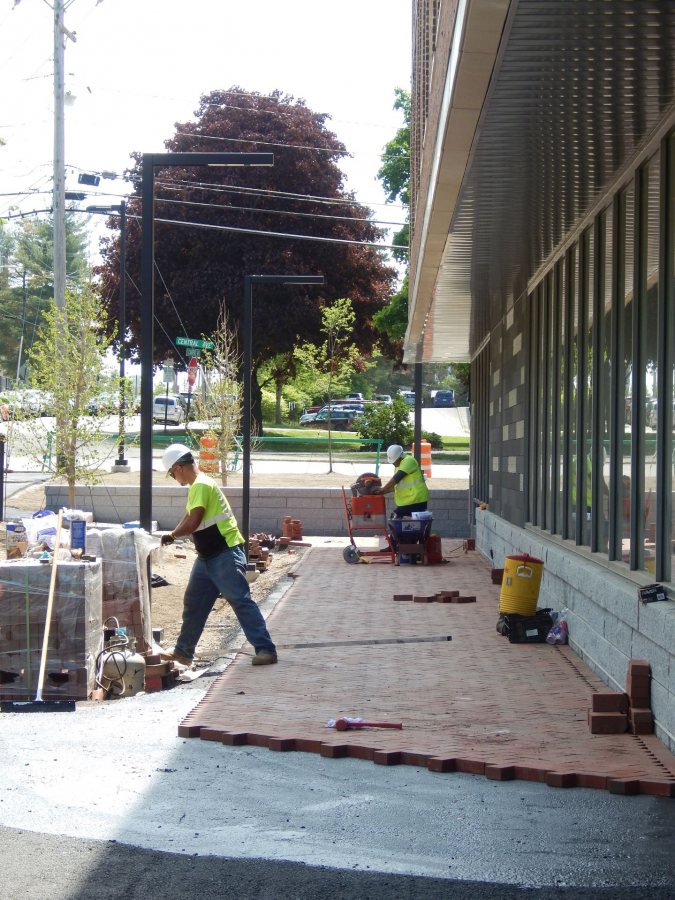
A new brick walkway at 65 Campus Ave. on May 31, 2016. The shiny stuff in the foreground is Karnak — no relation to Johnny Carson, it’s a sticky dilution of asphalt used to hold bricks in place. (Doug Hubley/Bates College)
At 55 Campus, meanwhile, site subcontractor Gendron & Gendron has been busy doing work much like what we saw at 65 in March and April: digging runoff basins, hauling away Jersey barriers, pouring concrete seating walls, setting light bases, placing new curbing, ripping out old sidewalks.
All this amidst a shifting hill-scape of dirt piles in different colors, all of them brown, that will be layered, as we’ve previously explained, in storm drainage features to filter storm runoff.
Inside story: During a recent visit to the lobby of 65 Campus, we took care not to wander onto large patches of floor that were sticky with adhesive awaiting its cover of carpeting.
In the Post and Print area, a carpenter was fastening red-oak trim on a staircase railing. Up on the third floor, a technician for Minuteman Security Technologies was troubleshooting the door-access system.
Setting aside the first floor, future home of the College Store and Post and Print services, much of the interior work remaining at 65 Campus consists of systems testing — aka commissioning, the process of putting mechanical, electrical, telecom, etc., infrastructure through its paces.
For example, in the labyrinth of halls and rooms at the back of the first floor, we noticed a large blue hood in one room. That device, explained project manager Chris Streifel, is used to test the ventilation system, measuring the airflow emitted by each diffuser — that is, air vent.
“You make sure your flows are as they’re supposed to be, and if not, there are dampers in the duct that allow you to adjust the openings,” he explained. The overall goal is to balance the diffuser outputs for the entire ventilation system (a prospect that reminds us of the old joke about leveling a table by trimming its legs).
Punch-listing, the comprehensive quality inspection that, like commissioning, portends the end of a construction project, is essentially complete on the upper floors of No. 65, Streifel says. “They’re really waiting for the first floor and basement.”
A major job on the first floor is to finish fitting the giant sliding doors, custom-made from glass and metal, that will close off the College Store outside of business hours.
And later this month, Windham Millwork of Windham, Maine, will start to install the millwork it has crafted for the store — the cash-wrap counter, tables, shelving, etc. Windham’s handiwork is already much in evidence, as the firm has created all the red-oak treatments already in place in both buildings.
Appearing in the store at the same time will be the modular retail fixtures, such as clothing racks and other mass-produced displays, that will complete the store’s furnishings.
Over at No. 55, too, the first floor is the site of most of the outstanding work that doesn’t involve testing. Finish work is ongoing in the lobby and, at the rear of the building, in the game room and kitchen, where appliances also await installation.
Punch-listing and commissioning are ongoing at the core of the building — the central sections of each floor where services are concentrated.
End game: An important protocol in the construction industry determines who is in charge of the property being built. During the construction, the general contractor or project construction firm — in this case, Consigli Construction of Portland — has responsibility for and authority over the buildings.
Only when the project is done will the literal owner of the buildings take charge. For 55 and 65 Campus Ave., Bates will get the keys at the end of July. And a lot needs to happen between now and then.
“It’s getting exciting, right? To me, it feels like it’s going to be August tomorrow,” Streifel laughed.
While Consigli has kept this project on schedule, Streifel noted that in general, the late stages of a major construction project have their own intrinsic challenges.
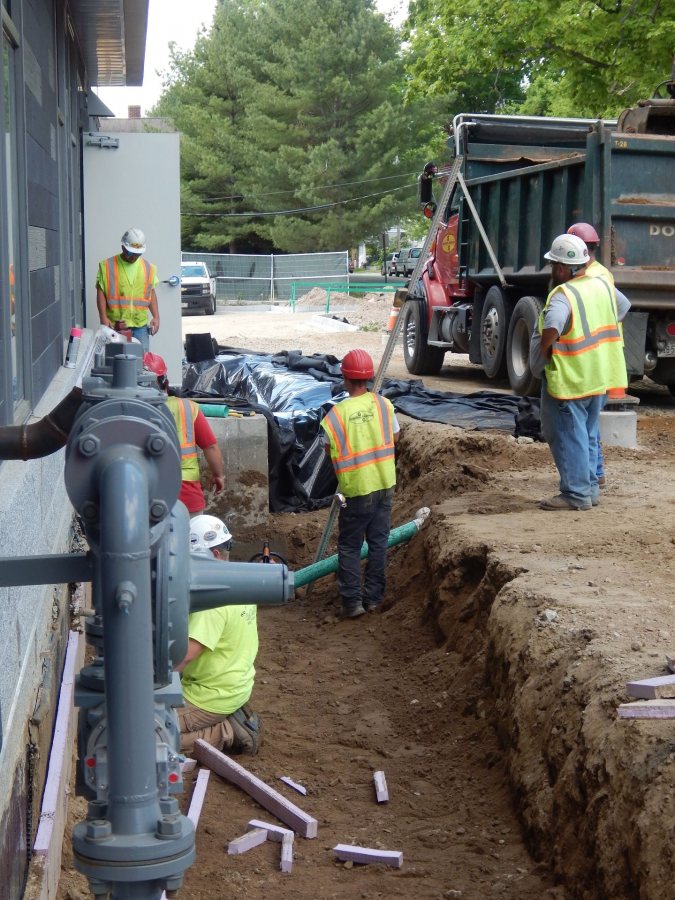
Shown on May 31, 2016, workers for Gendron & Gendron build a feature to divert stormwater runoff at 55 Campus Ave. (Doug Hubley/Bates College)
When a project is at its height of activity, with many tasks involving many different trades, a hold-up with one job just means that you shift the focus elsewhere while the problem is rectified, Streifel explained.
“We’ll hold off over here, and start work over there while we figure that out. There are different ways of absorbing those speed bumps, which are always part of this process.”
“But once you get near the end,” he said, “you don’t have that luxury anymore.” With fewer and fewer things on the list, a hang-up with any one of them has a greater potential to stall the whole works.
And then there’s summer, which gives with one hand and takes away with the other. For sure, nice days make it easy to do outdoor work (although the recent lack of rain has done no favors for the barren strawberries and the blackgum trees).
But summer is also the construction industry’s busy season, said Streifel, and “we’re competing more and more now against other jobs around the state.” With a limited pool of construction workers in Maine — a pool that has not regained its pre-recession numbers — the availability of those workers is precious.
“So each and every day we get folks on the job, it’s more and more important to make good use of them, because they’re being pulled in a lot of different directions,” Streifel said.
Can we talk? Campus Construction Update welcomes your questions and comments about current, past, and future construction at Bates. Write to dhubley@bates.edu, putting “Campus Construction” or “Perhaps trying to compensate” in the subject line. Or use the 21st-century commenting system below.
